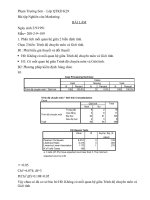Bài tập cá nhân services marketing crm
Bạn đang xem bản rút gọn của tài liệu. Xem và tải ngay bản đầy đủ của tài liệu tại đây (155.19 KB, 15 trang )
BÀI TẬP CÁ NHÂN SERVICES MARKETING - CRM
: SERVICES MARKETING - CRM
CONTENT
I. INTRODUCTION
Nowadays, we are accustomed to using service. Every year, it has a great
contribution in GDP of a country. Service has a very important role in our economy.
According to Philip Kotler, sevice is defined as “A service is any act or performance one
party can offer to another that is essentially intangible and does not result in the
ownership of anything. Its production may or may not be tied to a physical product.
Increasingly, manufacturers, distributors, and retailers are providing value-added
services, or simply excellent customer service, to differentiate themselves. Many pure
service firms are now using the Internet to reach customers; some are purely online”.
(Kotler, Philip 14th ed, p.355).
Common examples of service marketing are found in telecommunications, air
travel, health care, financial services, all types of hospitality services, car rental services,
and professional services.
After learning the marketing management, I decide to search the topic “Services
marketing – CRM” for understading this subject clearer. This assigment includes three
parts: the introdution, the body and the conclusion. Some examples will show to illustrate
for the theories of marketing management. My assigment will focus on some contents:
the role and significance of services in the modern economy, the marketing planning
process; monitory marketing planning and services; service market segmentation,
customer loyalty, etc…
II. BODY
1. Explain the role and significance of services in the modern economy.
1
According to Valarie Zeithaml & Mary Jo Bitner “Services are deeds, processes,
and performances”, “A service is a time-perishable, intangible experience performed for a
customer acting in the role of a co-producer” (James Fitzsimmons)
Service sector is the lifeline for the social economic growth of a country. It is
today the largest and fastest growing sector globally contributing more to the global
output and employing more people than any other sector.
The real reason for the growth of the service sector is due to the increase in
urbanization, privatization and more demand for intermediate and final consumer
services. Availability of quality services is vital for the well being of the economy.
For developing countries and least developed countries (LDCs), service trade is
the new frontier for enhancing their participation in international trade and, in turn,
realizing development gains. However, positively integrating developing countries,
especially LDCs, and Land-Locked Developing Countries (LLDC) into the global
services economy and increasing their participation in services trade, particularly in
modes and sectors of export interest to them, remains a major development challenge.
The service has a positive effect on:
Leadership and communication skills
Spiritual growth and moral development
Cultural and racial understanding
Career development
Personal identity
Services are important in Vietnam, because :
+ They are facilitators of domestic growth.
2
+ They anchor and support the entire goods production process by providing
value-added inputs for competitive industrial development. However, in Vietnam policy
appears focused on final demand services, with a major degree of “internalization”.
+ They are increasing as a percentage of world trade and FDI: in Vietnam
services trade deficit is growing/ expectations are low
+ They contribute to job creation: in Vietnam the shift of labour structure out of
agriculture and into services is still low
In Vietnam, the national services strategies aim to develop an efficient and
internationally competitive services sector in order to: Provide high value added inputs to
export-oriented industries; Reverse the growing deficit in services trade by increasing
services exports; Provide an attractive environment for FDI; Support sustainable growth
& transfer to a knowledge-based economy; Assist in meeting national human
development objectives for poverty alleviation.
2. Answer the following:
(a) The marketing planning process.
(b) Monitory marketing planning and services.
(a) The marketing planning process.
The marketing planning process has an important role in marketing. It has a close
relationship both objectives and specifications of the service that a company want to do.
There are 5 basic steps in this process, these are:
1. Determine the company’s objective: When set up a marketing planning, the
marketing planning must be suitable to the organization’s objectives or mission.
This is also the method and the right direction for marketing department to set up a
marketing planning well.
3
2. Assess the Resources: This steps must be suitable to the finance’s limit. The
marketing department must be included in production capacity, finance,
technology and human resources. This step must be balanced with many factors,
both inside and ouside of the organization.
3. Eveluate risks and opportunities: Marketing planning must be focus on both risks
and opportunities. Besides, this planning must calculate ROI (Revenue on
Investment), take advantages and decrease risks. There are many factors that can
be risks or opportunites when doing the planning; such as : competitors, politic,
economic status, technology, consumers,….
4. Set up marketing strategy: Based on some privious steps, the marketers begin to
design a marketing planning. The marketing planning must be directed to establish
the right marketing or business strategy; it is also easy for flexibility. The
marketing planning usually target to the market segmentations, potential
customers,…
5. Implement, monitor and valuate the planning: At every step, marketers must be
monitor the result and evaluatate the feedback to adjust the marketing strategy
flexibly.
(b) Monitory marketing planning and services
In order to do a marketing planning well, there are some advice that is necessary to do
some things, such as:
1. Implement marketing plans
1. Activities from the marketing plan are prioritised and resources obtained for their
implementation.
2. Those involved in the marketing effort are briefed on their roles and
responsibilities to ensure the success of the marketing strategy.
4
3. Specific marketing plans are implemented in accordance with the organisation's
overall marketing strategy and business plan.
4. Staff are trained (where required) to participate effectively in the implementation
of aspects of the organisation's marketing strategy and marketing plans.
2 . Monitor and review marketing performance
1. Progress against performance targets in the marketing plan is monitored to
determine whether the organisation is achieving its marketing strategy.
2. Marketing outcomes and performance are recorded to enable comparisons with
planned marketing objectives.
3. Variations on predicted results are analysed and recorded.
4. Reports on progress against marketing plans are prepared and distributed to
appropriate personnel.
3 . Evaluate and review marketing plan
1. Marketing plan is evaluated against organisation strategy and direction.
2. Staff are encouraged to propose ways of improving marketing performance.
3. Customer reaction to all aspects of the marketing is obtained to improve targeting
and identify opportunities for improvement.
4. The marketing plan is adjusted in light of performance and customer feedback.
For example, when setting up a marketing planning for “Phở 24”, the marketer must be
focus on many things that can influence on the marketing performance.
As we know, “Phở” is a famous food in Vietnam. Vietnamese people like pho; especially
in the North. The southern people in VN like “hu tieu” (rice noodle). A marketing
planning for “pho 24” usually focus on these things:
5
+ Product: delicious, nutrious and natural ingredients.
+ Price: affordable price (30,000 VND – 60,000 VND)
+ Place: convenience for many people. It also has many branches in Ho Chi Minh city,
Ha Noi, Da Nang,… and overseas branches…
+ Promotion: promote the Pho 24 brand in many newspaper of tourism, or magazine of
tourism or cuisine…
When setting up a marketing strategy, Pho 24 usually focus on their branding; and
transmit to the customer for their message. They use voucher for the customers who want
to sign the long-term contract or discount for many companies. Beside that, Pho 24 apply
the franchise to develop their branch in VN and overseas. Monthly, the marketing
deparment has a marketing report to monitor the business revenue or the trend of
marketplace or the business report of their branches. They can change their marketing if
they think that it is necessary to adjust.
3. Answer the following:
(a) Service market segmentation.
(b) Customer loyalty.
a) Service market segmentation
Market segmentation is the process of identifying and analyzing subgroups of buyers in a
product-market with similar response characteristics (Cravens & Piercy, 2006, page 97).
è each segment’s buyers are assumed to be quite similar in wants and needs.
Here are some reasons that we must do market segmentation:
• We can not satisfy everyone in a market: every market is specialised by some
features regarded to income, needs, or interests,…
6
• It creates the largest potential market: the larger market is expanded, the more
complicated we will get. The market segmentation can help company control its
capacity to supply its goods and services well.
• lowest costs: because the market is divided into many segements, the marketing
cost will be reduced considerably.
• lower prices: the price that a marketing planning aim to can be low or high price.
But many companies usually choose the low price. Because the lower price is, the
more profit company will get.
• higher margins: every segment will help a company get the high revenue;
especially, if a company specilizes in producing the competitive product and
monopoly, it will get considerable profit.
There are many levels of market segmentation, such as:
• Segment marketing: large identifiable group within a market, with similar wants,
purchasing power, geographical location, buying attitudes, or buying habits.
• Niche marketing: more narrowly defined group, typically a small market whose
needs are not being well served.
• Local marketing: the needs and wants of local customer groups (trading areas,
neighborhoods, even individual stores).
• Individual Marketing: one-to-one marketing.
There are many patterns of market segmentation, such as:
• Homogeneous preferences: all consumers have the same preference.
• Diffused preferences: consumer preferences may be scattered throughout the
space.
7
• Clustered preferences: The market might reveal distinct preference clusters.
For implementing market sedgementation for a product/ service, there are some steps we
can do:
• Survey: research on the customer’s motivations, attitudes, and behaviors :
+ Geographic: nations, states, regions, counties, cities, or neighborhoods
+ Demographic: age, income, generation, social class
+ Psychographic: Lifestyle, Personality, Values
+ Behavioral: Occasions, User status, Usage rate, Loyalty status, Buyer-readiness
stage
+ Analysis: analyze the collected data to create different clusters.
+ Profiling: Each cluster is profiled in terms of its distinguishing attitudes,
behavior, demographics, psychographics, and media patterns, then each segment is
given a name based on its dominant characteristic.
b) Customer loyalty
According to Philip Kotler: customer satisfaction is defined as the status of the
consumer who want to buy the products which need their maximal benefits and the
products must provide higher benefits than what they expected. (Kotler, Philip, 2003,
Courtesy of Marketing Management).
• These are some repeat customer’s behaviors:
– offer good ratings, reviews… regarding a products, services.
– offering favorable word of mouth publicity regarding a product, telling
friends and family, and adding them to the number of loyal customers.
8
For satisfying the customers’ wants, the entrepreneurs can do some following basic
steps, these are:
1st step: Check the level/scale of customer satisfaction
This method helps entrepreneurs check the level of customer satisfaction by
questionnaires, vote, customers’ suggestion, sales revenue .
2nd step: Find/Discover the causes/reasons
A unsatisfied customer usually falls into the three following factors :
+ Product : Customers complain about quality, designs, packagings, categories ,
product’s price, warranty policy , after sales services, etc. ..
+ Price : high price or low price , affordable or not for their income .
+ Convenience : the way of delivery , payment , transaction location , time and
flexibility .
+ People : Many customers often complain about the attitude and skills of
individual employees .
* 3rd step: Solve the problems to analyze of customers loyalty.
For illustrating the applicaon of above steps, I propose the case of PACE Vietnam.
Type of business : Education. Business Object: Institute of Leadership and Management.
Further information: The Institute of Leadership and Management (or PACE) is a leading
institute of leadership in VN. PACE's mission is "to contribute to shaping a new business
society in Vietnam by developing leadership capacity, professional capability and
business knowledge for individuals and organizations in order to succeed on both local
and global scales”.
After each courses, PACE usually eveluate the scale of the learner’s satisfaction
by applying these steps:
1st step: Check the level/scale of customer satisfaction. PACE values the
customer’s satisfaction by questionnaires, learners’ votes after each courses, and the
frequency of their come back.
9
2nd step: PACE find/Discover the causes/reasons. If customers dissatisfy, PACE
will check and discover the problems, such as: the quality of studying programme, price
is or not competitive? The studying schedule is convenient? Teachers’ support or
facilities for studying process is good or bad?
3rd step: Solve the problems.
5. Write a detailed note on pricing strategies for services.
There are many ways to set up a price strategy for services. It depends on the type of
service a company is aiming to, or the company’s strategy want to do. The pricing
objectives provide general directions for action, according to Oxenfeldt (1983) defines
pricing methods as the explicit steps or procedures by which firms arrive at pricing
decisions. These are some advice to set up a pricing strategy.
1. Cost-based methods:
- Cost-plus method – a profit margin is added on the service’s average cost.
- Target return pricing – the price is determined at the point that yields the firm’s target
rate of return on investment.
- Break-even analysis – the price is determined at the point where total revenues are equal
to total costs.
- Marginal pricing – the price is set below total and variable costs so as to cover only
marginal costs
2. Competition-based methods:
- Pricing similar to competitors or according to the market’s average prices.
- Pricing above competitors
- Pricing below copetitors
10
- Pricing according to the dominant price in the market – the leader’s price that is adopted
by the rest of the companies in the market.
3. Demand-based pricing:
- Perceived-value pricing – the price is based on the customers’ perceptions of value.
- Value pricing –a fairly low price is set for a high quality service.
- Pricing according to the customers’ needs – the price is set so as to satisfy customers’
needs.
For illustrating the way a company use these pricing strategy, I propose the pricing
strategy of PACE Vietnam. Some courses that PACE holds on, such as: Leadership &
Management, Human Resources, Finance & Accounting, Sales & Marketing, Production
& Operation, Business Law, Soft skills and other courses…
PACE Vietnam use the demand-based pricing and the competition-based methods.
PACE applies the demand-based pricing strategy, aims to the target customers, that are
the learners who need to improve their knowledge and skills in business, customers
mainly are: people need to improve their business knowledge and business skills; or
businessmen gather to meet and share their experiences or experts in economics, some
administrative agencies and companies need to train their human resources.
The Price mostly is ranged from 2,000,000 VND to over 10,000,000 VND per course;
especially it can be calculated that based on the demand-based price of the training
contract and pricing can be similar to competitors or according to the market’s average
prices.
6. Answer the following:
(a) Explain the role of marketing communication.
(b) Service promotion.
11
a) Explain the role of marketing communication:
Marketing communications involves the creation and delivery of messages though
selected media to communicate with one or more markets. Marketing communications
play an increasing number of roles with the expansion of communication options in areas
such as social media.
Communication is the way a company conveys a message from one individual or
group to another. This process usually involves a few steps. Companies will create the
message, select a medium for delivery and send the message. Individuals receiving the
message will interpret the communication, act on it and provide feedback if necessary.
These basic steps dominate the communication process.
Companies typically have a few standard mediums in which they deliver
marketing messages. Radio spots, television advertisements, billboards, print
advertisements and Internet-based messages are the most common communication forms.
Companies use each medium to reach as many customers as possible with their
company's marketing message. Business owners and managers can also tailor their
communication to specific groups using a variety of communication mediums.
Business communication in marketing often takes on one of two forms: direct or
indirect. Direct messages come straight from the company in the form of fliers,
promotions and in-store signage. Indirect messages come through traditional mediums,
such as television, radio and newspapers. While indirect communication methods reach
more consumers, they do allow a company's marketing message to become mixed with
other marketing messages. Direct marketing is a targeted approach meant to build
customer relationships.
One of the most important aspects of marketing communications is branding.
Branding has never been as important as it is right now. Done successfully, it can give
your company a competitive advantage over others in the market and really launch your
12
company to the next level; on the other hand, poor branding can see your company fall
into obscurity just as quickly.
b) Service promotion
To promote a service well, it is necessary to prepair for some things before you do.
To save money, or reduce cost, you can use internet marketing for promoting your
service. The combination of traditional marketing and online marketing can help you
promote your service well and completely.
1. Get business cards printed up. This is a must. Anywhere you go, hand them out,
and give them to your friends so they can hand them out as well. Consider using
an online discount site to get your cards made up.
2. Set up a listing on Google Maps. This is a free service and your business will
show up on Google's local map when a potential client types in your type of
business along with your city. Many other search engines offer similar types of
listings.
3. Buy a domain name and design a low-cost website. GoDaddy offers a tool that lets
you create your own site, so you're in charge of the content, while still being very
affordable. A site with 5 or 10 pages will suffice for most businesses; your contact
information, a short bio, some pictures, your menu (if applicable) and prices are
the basic things to add to your site. Put your web address on all promotional
materials.
4. Offer a referral discount to your current customers. For every new (paying) client
they refer to you, give them something like 10 percent off their next service. You
could also offer a punch card that you punch every time they spend a certain dollar
amount; when the card is full, they receive a discount or a free service. This is a
great tool as carrying around the card will keep your business on their mind, and
the fact they are getting something free out of it, will motivate them to come back.
13
5. Create some fliers to distribute to surrounding apartment complexes, businesses
and schools. Tailor them to each population's needs (i.e., make senior discount
coupons to hand out to assisted living facilities). Make these using a word
processor - print two or four ads per page, then get them copied on colored paper
and distribute them to your target market. Some pizza restaurants will allow you to
put fliers on the tops of their boxes for a small fee.
6. Fax a flier to local businesses that may be interested in your services. It may look
similar to the fliers in Step 5 but make an ad that is a full page - it must be legible
to the recipient and sometimes fax machines can distort the copy. Include a
coupon on the flier, or advertise a new service they may be interested in.
7. Talk to owners of local coupon books. Ad space in these small newsprint books is
cheap and doesn't usually require a long contract. Consider asking them to barter
with you--that's the great thing about owning a service business.
8. Donate your services to a local charity. Give a gift certificate to a silent auction or
sponsor an event. This will also help your public image.
III. CONCLUSION
In conclusion, a marketing campaign must be suitable and effective. Implementing
a good marketing campaign must be researched carefully; besides that, the marketer
should control it so as to have a good performance. Services marketing is a sub field of
marketing which covers the marketing of both goods and services. Goods marketing
includes the marketing of fast moving consumer goods (FMCG) and durables. Services
marketing typically refers to the marketing of both business to consumer (B2C) and
business to business (B2B) services.
Understanding and applying the knowledge of marketing management well will be
useful to create successful result in business. This ensures entrepreneurs to set up a strong
position in domestic and global market in the modern economy.
14
REFERENCE
1. Documents, presentations of the guiding teacher of Marketing Management.
2. Marketing process. Available at : /> (Accessed: May 10th 2014)
3. Kotler, Philip (2012), Marketing management, 14th edition, Pearson Pulishing
House.
4. Services marketing . Available at:
. (Accessed : May 11th 2014)
5. Website of PACE Institute of Management (2014). Available at:
(Accessed: May 10th 2014)
And other useful documents.
15









